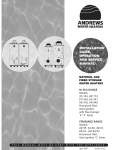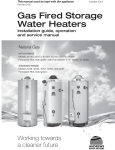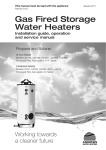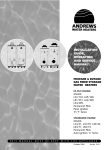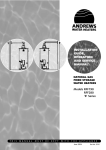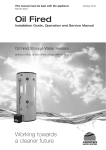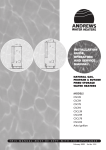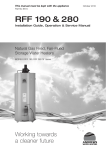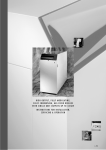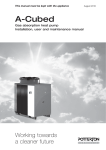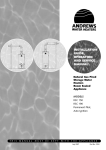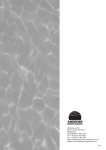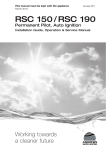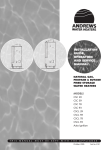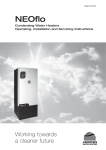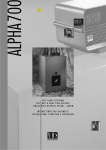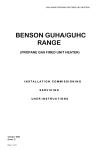Download andrews 84/87 Installation guide
Transcript
This manual must be kept with the appliance January 2011 Part No E132 Gas Fired Storage Water Heaters Installation guide, operation and service manual Natural Gas HI-FLO RANGE Models 32/143, 65/173, 81/264, 62/341, 54/418, 54/440 Permanent Pilot, Auto Ignition with Flue Damper ‘E’/‘F’ Series STANDARD RANGE Models 24/39, 32/40, 40/61, 63/62, and 84/87 Permanent Pilot, Auto Ignition ‘G’ Series Working towards a cleaner future © Copyright Andrews Water Heaters 2007 Reproduction of any information in this publication by any method is not permitted unless prior written approval has been obtained from Andrews Water Heaters. Andrews Storage Water Heaters have been designed and manufactured to comply with current International standards of safety. In the interests of the health and safety of personnel and the continued safe, reliable operation of the equipment, safe working practices must be employed at all times. The attention of U.K. users is drawn to their responsibilities under the Health and Safety Regulations 1993. All installation and service on the Andrews Water Heater must be carried out by properly qualified personnel, and therefore no liability can be accepted for any damage or malfunction caused as a result of intervention by unauthorised personnel. The Andrews Water Heaters policy is one of continuous product improvement, and therefore the information in this manual, whilst completely up to date at the time of publication, may be subject to revision without prior notice. Further information and assistance can be obtained from: Andrews Water Heaters Wood Lane, Erdington, Birmingham B24 9QP Technical Helpline Tel: 0845 070 1057 Fax: 0845 070 1059 THE ANDREWS WATER HEATERS COVERED IN THIS MANUAL ARE FOR USE WITH NATURAL GAS ONLY CONTENTS SECTION 1 SECTION 2 SECTION 3 SECTION 4 SECTION 5 SECTION 6 SECTION 7 SECTION 8 SECTION 9 PAGE GENERAL AND SAFETY INFORMATION General Information British Standards Health and Safety Regulations 1993 Legionellae in Water Heaters 2 2 3 3 TECHNICAL DATA Standard Range Hi-Flo Range 4 5 INSTALLATION Introduction Draught Diverter Location Gas Supply Electrical Supply Flue Systems Air Supply and Ventilation Water Quality and Treatment Water Connections- Hydrojet System Vented Systems, Standard Range Unvented Systems, Standard Range Vented Systems, Hi-Flo Range Unvented Systems, Hi-Flo Range 6 6 6 7 8 10 12 14 15 16 18 20 23 COMMISSIONING Standard Range Hi-Flo Range 26 28 OPERATION Standard Range Hi-Flo Range 35 35 SERVICING Introduction Burner Assembly, Standard Range Burner Assembly, Hi-Flo Range Gas Control Valve, Standard Range Gas Control Valve, Hi-Flo Range Flue Ways Cleaning the Storage Vessel Magnesium Anode(s) Safety Valve 36 36 36 37 37 37 38 38 38 REPLACING COMPONENTS, Hi-Flo RANGE Gas Control Valve Burner 40 40 FAULT FINDING Permanent Pilot Models - Standard and Hi-Flo Range All Models Auto Ignition Models, Hi-Flo Range 41 42 43 PARTS LISTS AND ILLUSTRATIONS Standard Range Hi-Flo Range Unvented Systems Kit 24V Auto System Kit 45 46 50 52 SECTION 1 GENERAL INFORMATION GENERAL AND SAFETY INFORMATION The Andrews Water Heater has been designed for use with NATURAL GAS only and is manufactured to give an efficient, reliable and long service life. To ensure the continued, trouble-free operation of your heater at maximum efficiency, it is essential that correct installation, commissioning, operation and service procedures are carried out strictly in accordance with the instructions given in this manual. By law, installation and commissioning of the heater must be carried out by properly qualified personnel. The The The The heater(s) must be installed in accordance with the following requirements; current GAS SAFETY (INSTALLATION AND USE) REGULATIONS current BUILDING REGULATIONS Water Supply (WATER FITTINGS) REGULATIONS 1999 Additionally, installation should be performed in accordance with all relevant requirements of the Gas Supplier, Local Authority and recommendations of the British Standards and Codes of Practice detailed below. BRITISH STANDARDS AND CODES OF PRACTICE STANDARD RANGE BS 6700: 1997 Specification for design, installation, testing and maintenance of services supplying water for domestic use within buildings and their curtilages. This standard supersedes the following British Standards and Codes of Practice: CP99, CP310, CP324, 202, CP342 Part 2, Centralised Hot Water Supply. BS 5440 Part 1:2000 Part 2:2000 Installation of flues and ventilation for gas appliances of rated output not exceeding 60kW. Specification for installation of flues. Specification for installation of ventilation for gas appliances. BS 5546:1990 Installation of gas hot water supplies for domestic purposes. BS 6891 Installation of low pressure gas pipework of up to 28mm in domestic premises. BS 7206:1990 Specification for unvented hot water storage units and packages. I/M2 I/M5 Purging procedures for non-domestic gas installations. Soundness testing procedures for industrial and commercial gas installations. Flues for commercial and industrial gas fired boilers and air heaters. Notes on installation of gas pipework (excluding 25mm and below). I/M11 I/M16 IGE/UP/10 Pt.1 Edition 2 Installation of Gas Appliances in Industrial and Commercial Premises Hi-Flo RANGE As STANDARD RANGE plus: BS 6644: Installation of gas fired hot water boilers of rated inputs between 60kW and 2MW. NOTE: 2 Consideration should be given to amendments or updates to the above standards. GENERAL AND SAFETY INFORMATION It is the duty of manufacturers and suppliers of products for use at work to ensure, so far as is practicable, that such products are safe and without risk to health when properly used and to make available to users, adequate information about their safe and proper operation. Andrews Water Heaters should only be used in the manner and purpose for which they were intended and in accordance with the instructions in this manual. Although the heaters have been manufactured with paramount consideration to safety, certain basic precautions specified in this manual must be taken by the user. SECTION 1 HEALTH AND SAFETY REGULATIONS 1993 It is imperative that all users of the heater must be provided with all the information and instruction necessary to ensure correct and safe operation. Water systems in buildings have been associated with outbreaks of Legionnaires' Disease, particularly in health care facilities where occupants are significantly more susceptible to infection. EFFECTIVENESS IN COMBATING LEGIONELLAE In recognition of the risks in hospitals, a Code of Practice for the Control of Legionellae in Health Care premises has been issued by the Department of Health (1991). Codes of Practice applicable to other premises have been published by other organisations, principally the Health and Safety Executive (HS)(G70) and the Chartered Institute of Building Services Engineers (CIBSE, TM13). All Codes of Practice draw attention to the design and operation of water systems with reference to avoidance of factors that favour colonisation by Legionellae bacteria. These factors include stagnation, lukewarm conditions (20ºC to 45ºC) and the accumulation of debris, scale and corrosion in the base of tanks and calorifiers. Andrews Water Heaters has commissioned an independent evaluation of their products to investigate their resistance to build-up of legionellae bacteria. Experiments were conducted to determine whether, following a substantial challenge by legionellae pneumophilia, after overnight and stagnation conditions, the system was rendered free from viable recoverable legionellae. It was found that at 61ºC, following a challenge of approximately 107 organisms per litre, within one hour, more than 99.999% of organisms had been killed. After a subsequent stagnation period, sampling did not reveal any residual contamination. The design of the base of the water heater precludes legionellae colonisation, even after build-up of debris. The burner positioning ensures that the water at the bottom of the heater reaches the same, or higher temperature as in the rest of the heater. Based on data obtained through experiment, the Andrews Water Heater can be described as legionellae resistant as it is considered unlikely that, at the temperature tested, the organism would colonise the water heater and present a possible health risk. 3 SECTION 2 STANDARD RANGE TECHNICAL DATA ANDREWS MODEL NO. 24/39 32/40 40/61 63/62 84/87 Storage Capacity l gal 109 24 145 32 182 40 286 63 382 84 Recovery thro' 44ºC/80ºF l/h gal/h 178 39 182 40 278 61 281 62 397 87 Recovery thro' 56ºC/100ºF l/h gal/h 142 31 146 32 220 49 227 50 316 70 Heat Input Gross kW Btu/h 12 12.5 19 19 26 40,944 42,650 65,000 65,000 88,712 Heat Input Net kW Btu/h 11 11.4 17 17 24 37,532 38,900 58,004 58,004 81,888 Gas 4 NATURAL CAT I2H Burner Gas Pressure mbar ins wg. 10 4 10 4 10 4 10 4 10 4 Max. Gas Input Pressure mbar ins wg. 35 14 35 14 35 14 35 14 35 14 Gas Flow Rate m3/h ft3/h 1.12 39.4 1.16 41.22 1.78 62.86 1.78 62.86 2.43 85.71 Gas Connection Rc (in BSP Int) 1/2 1/2 1/2 1/2 1/2 Flue Gas Temp. ºC 200 205 195 160 125 Flue Gas Volume m3/h 17 18 26 31 37 Gas Injector Orifice Diameter mm in 2.95 0.116 3.05 0.120 3.86 0.152 3.86 0.152 4.22 0.166 Flue Size (Secondary) mm in 100 4 100 4 100 4 125 5 125 5 Cold Water Feed Connection R (in BSP/Exl) 1 1 1 1 11/4 Hot Water Flow Connection R (in BSP/Exl) 1 1 1 1 11/4 *Return Connection Rp (in BSP/Int) 3/4 3/4 3/4 3/4 3/4 Drain Port Size R (in BSP/Ext) 3/4 3/4 3/4 3/4 3/4 Max. Working Pressure bar lbf/in2 10.3 150 10.3 150 10.3 150 10.3 150 10.3 150 Max. Test Pressure bar lbf/in2 20.6 300 20.6 300 20.6 300 20.6 300 20.6 300 Weight Empty kg lb 43 94 57 126 65 144 110 244 181 400 Weight Full kg lb 151 334 202 446 247 544 396 874 562 1240 Shipping Weight kg lb 44 98 59 131 68 150 120 264 194 428 Shipping Dimensions Depth mm in 546 211/2 587 231/8 587 231/8 692 271/4 914 36 Shipping Dimensions Width mm in 486 537 537 19 1/8 21 1/8 21 1/8 651 762 25 5/8 30 Shipping Dimensions Height mm in 1194 47 1575 62 1245 49 1499 59 1829 72 TECHNICAL DATA SECTION 2 ANDREWS MODEL NO. 32/143 65/173 81/264 62/341 54/418 54/440 Storage Capacity l gal 145 32 295* 65 368* 81 282* 62 245* 54 245 54 Recovery thro' 44ºC/80ºF l/h gal/h 649 143 786 173 1199 264 1549 341 1900 418 1998 440 Recovery thro' 56ºC/100ºF l/h gal/h 517 114 629* 138 959 212 1239* 273 1520* 334 1598* 352 Recovery thro' 72ºC/130ºF l/h gal/h 399 88 484* 106 730 162 953* 210 1169* 257 1223* 270 Heat Input Gross kW Btu/h 42.8 50 80 102 128 139 kW Btu/h 39 Heat Input Net Hi-Flo RANGE 146,034 170,600 272,960 384,024 436,736 474,268 45 73 93 116 126 133,068 153,540 249,076 317,316 395,792 430,000 Gas NATURAL CAT I2H Burner Gas Pressure Pernament Pilot mbar ins wg. 6.8 2.73 6.8 2.73 6.8 2.73 6.8 2.73 Burner Gas Pressure Auto Ignition mbar ins wg. 10 4 10 4 10 4 10 4 Max. Gas Input Pressure mbar ins wg. 35 14 35 14 35 14 35 14 Gas Flow Rate m3/h ft3/h 4.0 141 4.68 7.44 9.48 11.94 13.14 164.76 263.58 336.24 421.98 465.06 Gas Connection Rc 3/4 3/4 3/4 3/4 3/4 3/4 Flue Gas Temp. ºC 117 140 150 195 185 215 Flue Gas Volume m3/h 62 73 116 149 186 202 Gas Injector Orifice Diameter Permanent Pilot mm in 2.69 0.106 2.87 0.113 3.66 0.144 3.45 0.136 3.50 0.138 N/A N/A Gas Injector Orifice Diameter Auto Ignition mm in 2.40 0.094 2.58 0.101 3.25 0.127 3.18 0.125 N/A N/A 3.26 0.128 Flue Size (Secondary) mm in 150 6 150 6 200 8 200 8 250 10 250 10 Cold Water Feed Connection R (in BSP/Exl) 11/2 11/2 11/2 11/2 11/2 11/2 Hot Water Flow Connection R (in BSP/Exl) 11/2 11/2 11/2 11/2 11/2 11/2 *Return Connection Rp 3/4 3/4 3/4 3/4 3/4 3/4 Drain Port Size R 3/4 3/4 3/4 3/4 3/4 3/4 Max. Working Pressure bar lbf/in2 10.3 150 10.3 150 10.3 150 10.3 150 10.3 150 10.3 150 Max. Test Pressure bar lbf/in2 20.6 300 20.6 300 20.6 300 20.6 300 20.6 300 20.6 300 Weight Empty kg lb 190 419 200 441 289 637 257 566 269 594 269 594 Weight Full kg lb 335 738 495 1091 656 1447 538 1186 514 1134 514 1134 Shipping Weight kg lb 199 438 223 492 316 697 282 623 293 645 293 645 Shipping Dimensions Depth mm in 902 914 35 1/2 36 914 36 914 36 914 36 914 36 Shipping Dimensions Width mm in 768 762 30 1/4 30 762 30 762 30 762 30 762 30 Shipping Dimensions Height mm in 1270 50 2083 82 1960 77 1960 77 1960 77 (in BSP Int) (in BSP/Int) (in BSP/Ext) 1960 77 6.8 2.73 N/A N/A 10 4 35 14 * If the water heater is to be used on an unvented system, the combined temperature/ pressure relief valve must be fitted directly into the tank. The secondary return is then connected to the drain port via a suitable tee. 5 SECTION 3 INTRODUCTION INSTALLATION THE LAW REQUIRES THAT INSTALLATION IS CARRIED OUT BY A PROPERLY QUALIFIED PERSON Installations must be carried out in accordance with Gas safety (Installation and Use) Regulations 1998, Building Regulations, The Water Supply (Water Fittings) Regulations 1999 and any requirements of the local Gas Authority, Local Authority, Water and Fire Authorities and the current British Standards and Codes of Practice listed in Section 1. The fittings pack supplied with the heater contains the items listed below. 1 1 1 1 1 2 2 1 ASSEMBLING THE DRAUGHT DIVERTER - Installation and Service Manual. Coupler Socket 3⁄4in BSP. Gas Cock. Drain Cock. Flue Adaptor Socket (Where required). Cap End 11⁄2in BSP (Hi-Flo only). 11⁄2in x 3in Nipples (32/143 Model only). Warranty Card. The draught diverter must be assembled with the legs provided. Attach the legs to the draught diverter with the nuts and bolts provided. Fit the draught diverter (1) as shown in Fig.1 to the water heater using the screws provided. For Standard Range fit the draught diverter to the top of the water heater using the location holes. Top Connections 65/173 Top Connections 81/264 Only Elbows must be used Fig. 1 Draught Diverter Assembly In some cases, it may be necessary to drill the fixing holes in the top cover to fit the draught diverter to the water heater. By using the draught diverter as a template, position carefully over the flueway and mark the hole positions to be drilled 4mm. Fit the adaptor socket (2) and caulk into the draught diverter as shown in Fig. 1. LOCATION The location selected for installation of the heater must allow the provision of a satisfactory flue, adequate air supply, drain facilities and must be well illuminated. A purpose built boiler room or compartment is strongly recommended. A manual valve for isolation of the boiler room should be installed in the gas supply; it should be clearly identified and readily accessible for use at all times. If a purpose built boiler room is not available, measures should be taken to protect the heater from damage and prevent any extraneous matter from being stored on or around the heater. See BS 6644 Clauses 4, 5 and 6 for details. 6 INSTALLATION SECTION 3 The heater must not be installed in any location which contains a bed, bath or shower. LOCATION There must be easy access to the boiler room and heater at all times. A clearance of 800mm (311⁄2 in) for Hi-Flo and 300mm for Standard Range should be left at the front of the heater for removal of the burner. Clearances at the sides and rear of the heater should be at least 305mm (12 in). Service clearances for removal of the anodes and flue baffles should be provided as detailed below. STANDARD RANGE Models 24/39, 32/40, 40/61 Model 63/62 Model 84/87 762mm (30 in) 1143mm (45 in) 1270mm (50 in) HI-FLO RANGE Model 32/143 Model 81/264 Models 65/173, 62/341, 54/418, 54/440 597mm (231⁄2 in) 1300mm (52 in) 1143mm (45 in) The floor on which the heater is installed must be non-combustible, flat, level and of sufficient strength to withstand the weight of the heater filled with water (see Section 2, Technical Data) and should satisfy the requirements of the Local Authority and Building Regulations. NOTE: If the heater is in an exposed position and out of use during a period of heavy frost, it is recommended that the whole system is drained down to prevent damage due to the formation of ice inside the storage vessel. THE ANDREWS WATER HEATERS COVERED IN THIS MANUAL MUST ONLY BE USED WITH NATURAL GAS. GAS SUPPLY The installation of the gas supply must conform, depending on it's size, to the requirements of British Standards and Codes of Practice listed in Section 1 of this manual. A gas meter will be connected to the service pipe by British Gas plc or it's authorised contractor. The meter and service pipe should be checked by British Gas or it's authorised contractor to ensure that they are adequate to deal with the gas supply to the water heater(s) in addition to any existing or additional requirements. Gas Supply Cock, Standard Models Fit the gas supply cock immediately upstream of the gas control thermostat using a suitable jointing compound and connect to the gas supply. Do not apply heat in close proximity to the gas thermostat as damage to the control will result. A pressure test point nipple is fitted to the gas control thermostat at the gas inlet to test the incoming gas pressure. 7 SECTION 3 INSTALLATION GAS SUPPLY Gas Supply Cock, Hi-Flo Models Fig 2. Fit the gas cock immediately upstream of the gas control valve using a suitable jointing compound and connect to the gas supply. An inlet nipple complete with pressure test point nipple is factory fitted to the gas control valve to avoid possible damage. Gas Valve Gas Cock Nipple BSP Thread U.P.T. Thread Fig 2. Where the water heater(s) is(are) installed in a boiler house or purpose built compartment, a manually operated valve for the boiler house must be fitted in accordance with the Gas Safety (Installation and Use) Regulations 1998. The valve must be easily identified and readily accessible. After installation, the system should be pressure tested for soundness and purged in accordance with BS 6891 or IM/2 and IM/5 as appropriate. ELECTRICAL SUPPLY AUTO IGNITION UNITS HI-FLO MODELS - STANDARD RANGE MODELS External wiring to the water heater(s) must be installed in accordance with current I.E.E. Regulations for the wiring of buildings and to any Local Regulations that may apply. The Auto Ignition Heater is designed to operate from a 220/240V, 1Phase supply. The fuse rating is 5 amps. The method of connection to the mains electricity supply should facilitate complete electrical isolation of the appliance, preferably by use of an unswitched shuttered socket outlet in conjunction with a fused three pin plug, both complying with the requirements of BS 1363. Alternatively, a fused double pole switch or fused spur box serving only the heater may be used. The point of connection to the mains electricity supply should be readily accessible and adjacent to the appliance. Fig 3a and 3b. Connect the electrical supply to the main control panel terminal block via the cable glands in the base of the control panel. Mains input cable should be 0.75mm2, 3 core, and should be connected to the mains supply as detailed above. It is recommended that screen cable is used where the volt-free contacts are to be connected from an external supply. This will eliminate the risk of possible interference from nearby high voltage cables. Data sheets available for Hi-Flo and Standard Range, Automatic Ignition Control System. Contact Andrews Water Heaters. 8 INSTALLATION SECTION 3 Fig 3a. Standard Range Fig 3b. Hi-Flo Range 9 SECTION 3 FLUE SYSTEMS INSTALLATION Detailed recommendations for flue installation are given in BS 6644, BS5440 Pt 1 and British Gas publication IM/11 - Flues for Commercial and Industrial Gas Fired Boilers and Air Heaters. The flue connection is designed for BS 835 type heavy duty flue, but light quality flue pipe, mild steel or stainless steel sheet may be used using the appropriate adapter. Flue pipes etc. shall be fitted socket-up to keep any condensate within flue and appliance. Flues up to 200mm (8in) diameter should be fitted with a suitable British Gas Certified terminal. Fig 4a. The terminal position is most important and must be at least 1000mm (40in) above roof surfaces or at least 600mm (24in) above any parapet and clear of any adjacent obstruction as well as being clear of any openable windows, ventilators or features which could allow re-entry of flue products into the building. Pressure areas should also be avoided to prevent blowdown. See recommendations in BS 6644. BS 5440 Part 1 also provides useful additional advice. Terminal 1000mm 40” Minimum Roof Fig 4a. Terminal Flue materials, including jointing materials and fittings shall be asbestos-free, robust, durable, corrosion resistant and non-combustible and shall comply with BS 5854 and BS 715 or BS 4076 as appropriate, as well as being of a type accepted by the Local Gas Authority. When passing up through or adjacent to combustible materials, measures shall be taken to prevent the temperature of the combustible material from exceeding 60ºC (150ºF). The flue shall not be closer than 50mm (2in) to any combustible material except when passing through, when it must be enclosed by a non-combustible sleeve and separated from the sleeve by not less than 25mm (1in) air space. Flues shall be of a size not less than specified in Section 2, Technical Data (i.e. nominal flue size) and fitted so that there is no risk to persons in the building or from accidental damage. Fig 4b. If using an existing brick chimney, it should be swept and checked for soundness before connecting the flue and should take the shortest possible route and rise continuously to the terminal avoiding the use of 90º bends where a change of direction is required. Horizontal and very shallow runs of flue should be avoided since they impede the flow of gases and increase local cooling 10 INSTALLATION SECTION 3 FLUE SYSTEMS 600mm* Split Flue Clip 1. This flue run must not be used Fig 4b. 2 & 3 are recommended flue runs *A minimum of 600mm of vertical flue directly above the draught diverter should be provided where possible on all natural draught flue installations. If this dimension cannot be achieved please contact Andrews Water Heaters. Please note this is not required where a common flue header is used on multiple installations. Fig 5. Common flues may be used on multiple installations only if all the heaters are of the same burner system and fuel type and should be sized to ensure complete evacuation of the flue products from the installation. Where one flue is to be used more regularly or for longer periods than the others in the group, it should be connected at the point nearest to the main flue. See BS 6644 Clause 20 for further information and recommendations on this as well as general flue requirements. Each unit has an atmospheric burner system & uses natural gas. Heater with highest usage fitted nearest to main flue (if applicable) Fig 5. Fit a flue clip or flange joint close to the diverter so that it is secure but can be disconnected for servicing. The weight of the flue must be borne by securing clips, etc. and not by the heater. 11 SECTION 3 INSTALLATION Minimum Heights from Roof to Base of Flue Terminal Type of Roof Not within 1.5m (5ft) of a vertical surface of a structure ≠ on the roof Internal Route On Ridge Pitch exceeding 45º Pitched Pitch not exceeding 45º At or above ridge level 1m (3.3 ft) above roof intersection 1m (3.3 ft) above roof intersection 600 mm (2 ft) above roof intersection Not applicable 250 mm (10 in) above roof intersection Without parapet AIR SUPPLY AND VENTILATION External Route 600 mm (24 in) above roof intersection With parapet Flat Not on Ridge Within 1.5m (5ft) of a vertical surface of a structure ≠ on the roof External Route Internal Route The base of the terminal should be 600 mm (24 in) above the level of the top of the structure The base of the terminal should be 600 mm (24 in) above the level of the adjacent roof edge For all installations, please refer to the table below for calculating requirements. Detailed recommendations for the air supply are given in BS 5440 Part 2, BS 6644 Clause 19 and IGE/UP/10 Pt.1. The following notes are provided for general guidance only. Ventilation shall prevent the heater environment from exceeding 32ºC (90ºF). The purpose provided space in which the heater(s) are installed must have permanent air vents communicating directly with the outside air, at high and low level. Where communication with the outside air is possible only by means of high level air vents, ducting down to floor level for the lower vents must be used. For an exposed building, air vents must be fitted on at least two sides, preferably on all four sides. Air vents should have negligible resistance and must not be sited in any position where they are likely to- be easily blocked or flooded, or in any position adjacent to an extraction system which is carrying flammable vapour. Grilles or louvers should be so designed that high velocity air streams do not occur within the space housing the heater(s). The grilles should have a total minimum free area for the water heater(s) in addition to any other requirements as follows:Where the heater is to be installed in a room the following permanent ventilation is required: 5cm2 per kW in excess of 7kW net for installations up to 54kW net. For installations exceeding 60kW the following permanent ventilation is required: Low Level (inlet) 540cm2 plus 5cm2 per kilowatt in excess of 54kW total net input. High Level (outlet) 270cm2 plus 2.5cm2 per kilowatt in excess of 54kW total net input. Where the heater is to be installed in a compartment, permanent air vents are required in the compartment at high and low level. These air vents must either communicate with a room or internal space or be direct to outside air. The minimum effective areas of the permanent air vents required in the compartment are as follows;Air Vent Areas Position of Air Vents High Level Low Level Air from room or internal space 10cm2 per kW net 20cm per kW net 2 Air direct from outside 5cm2 per kW net 10cm2 per kW net Note:- Both air vents must communicate with the same room or internal space or must both be on the same wall to outside air. 12 INSTALLATION IMPORTANT! 1. The effective area requirements specified in the table are related to the maximum net input of the heater(s) and are equivalent to those specified in BS 6644 and IGE/UP/10 Pt.1. SECTION 3 AIR SUPPLY AND VENTILATION 2. The free area of the grilles should not be less than the size of the recommended ventilation opening. 3. The supply of air to a space housing the heater(s) by mechanical means should be: (a) Mechanical inlet with natural extraction. (b) Mechanical inlet with mechanical extraction. NOTE! Natural inlet with mechanical extraction must not be used. Where a mechanical inlet and mechanical extraction system is used, the design extraction rate must not exceed one third of the design inlet rate. All mechanical ventilation systems must be fitted with automatic gas shut off safety systems which cut off the supply of gas to the heater(s) in the event of failure of either the inlet or extract fans. The requirements for air supply by mechanical ventilation are given in BS 6644 Clause 19.3. and IGE/UP/10 Pt.1. The permanent air vents shall be sited away from any extract fans. Where an extract fan is fitted, check for spillage at the draught diverter as detailed in BS 5440 Part 1 Appendix B. It may be necessary to increase the ventilation area to compensate for the extract fan. 4. The vapours emitted by halogen based compounds can, if drawn into the combustion air, cause corrosion of the gas burner, thermocouple and storage vessel. Therefore, if heaters are to be installed in locations where halogens are likely to be present, they should be isolated from such compounds and ventilated from and to outside uncontaminated atmosphere. Some of the vulnerable areas are: (a) Hairdressing salons and adjoining rooms and basements (b) Establishments where dry cleaning solutions are used or stored. (c) Degreasing plants using hydrocarbon solvents. (d) Premises where refrigerant gases are used or stored. 13 SECTION 3 WATER QUALITY AND TREATMENT INSTALLATION Where extreme conditions of water hardness exist, scale can form in any water heating equipment, especially when the heater is working under conditions of constant heavy demand and at high temperatures. Each water heater is fitted with one or more magnesium anode(s) which protect the tank from corrosion caused by electrolytic action. Magnesium anodes are sacrificial in that they corrode as they protect. When the anode has eroded to less than 50% of it's original diameter, it may not offer protection.The anodes should be inspected annually and replaced as necessary. Frequency of anode replacement will vary dependent on water quality. Andrews Water Heaters offer CorrexTM UP powered anodes as an alternative to the standard magnesium anodes. These anodes do not need maintenance or replacement. The potentiostat which regulates the current to the CorrexTM anode, features an indicator light which shows green to indicate correct function and red to indicate malfunction. An additional CorrexTM BEMS version is available, which provides a remote warning signal. These anodes are available as an optional extra on all Andrews heaters. In hard water areas, scale formation can occur in hot water systems and hot water heaters and the higher the temperature and volume of water used, the more problematic the scale build-up can be. Water treatment is normally recommended when the hardness reaches 100 - 150ppm (7 - 10 degrees Clark) and above. This problem can be minimised by reducing the water temperature in the heater and by fitting suitable water pretreatment equipment. When installing Andrews Water Heaters in hard water areas we would recommend that a water treatment specialist is consulted. The following companies have supplied water treatment equipment in the UK for a number of years to various establishments including those where Andrews water heaters have been installed. WATER TECHNOLOGY LTD Powke Lane Ind. Estate Blackheath Birmingham B65 0AH Contact Gareth Morris Tel: 0121 561 3144 Fax: 0121 561 4184 LIFF INDUSTRIES LTD Bay Hall Miln Road Huddersfield West Yorkshire HD1 5EJ Contact Ingrid Ashman Tel: 0148 451 2357 Fax: 0148 451 3597 14 HYDROTEC (UK) LTD Hydrotec House Potts Place West Street Marlow Buckinghamshire SL7 2LY Contact Mark Darvill Tel: 01628 486774 Fax: 01628 486775 HYDROPATH (UK) LTD 2 Lenton Business Centre Lenton Boulevard Nottingham NG7 2BY Contact Glyn Appleby Tel: 0115 9422546 THE ENERGY SHOP Thames House 89 St Leonards Road Windsor Berkshire SL4 3BZ Contact Patrick McCart Tel: 0175 383 3880 Fax: 0175 383 3990 ECO SYSTEMS Po Box 330 Walton on Thames Surrey KT12 5YU Contact James Christie Tel: 01932 221679 INSTALLATION SECTION 3 WATER CONNECTIONS Hydrojet System The upper “jet ports” direct the flow outward to begin the dynamic mixing action. The lower “jet ports” direct the flow inward to increase the turbulence. Tank Heater Casing All models now incorporate the new Mini Hydrojet system on cold inlet side connections. This system ensures water is directed onto the tank base which minimises sediment build up from day one of installation. Mini Hydrojet Inlet Nipple (Side Cold Inlet Connection) The heater is fitted with the Hydrojet Total Performance System incorporated in the cold inlet dip tube. The tube is designed to increase turbulence and reduce sediment build up, reduce thermal stacking and increase delivery. 15 SECTION 3 WATER CONNECTIONS INSTALLATION VENTED SYSTEMS, STANDARD RANGE The water heater must be supplied from a cold water feed cistern and the hot water supply pipe must be fitted with an open vent pipe in accordance with BS 5546 and BS 6644. The Water Supply (Water Fittings) Regulations 1999 must be observed when installing the system. The cold water feed cistern must have an actual capacity greater than the hourly recovery rate of the heater or heaters to which it is fitted, the minimum actual capacity allowed for a feed cistern being 227 litres (50 gallons). The actual cistern capacity is the capacity to the normal water line of the cistern. All cisterns should be manufactured to the relevant British Standard. The distance from the normal water line to the top of the cistern should comply with that specified by the Water Authorities. The cold water inlet and hot water outlet connection nipples are identified on top of the heater. Connect the cold water feed and hot water outlet to these nipples with union adaptors for ease of servicing. CAUTION! DO NOT APPLY HEAT TO THESE NIPPLES IF MAKING CAPILLARY SOLDERED JOINTS AS THEY ARE FITTED WITH PLASTIC INSERTS. MAKE THE CAPILLARY JOINTS TO THE PIPES BEFORE CONNECTING TO THE HEATER. A DRAIN COCK IS SUPPLIED WITH THE HEATER AND THIS SHOULD BE FITTED TO THE APPROPRIATE BOSS AS SHOWN ON THE DRAWING. After installation of the water system, open the main water supply valve, flush the system and fill the heater. Open the hot taps to allow air to escape from the system. When the water is free of air, close the taps and check for leaks at the gas control thermostat, drain cock and the pipe connections at the top of the heater. All water connections for Standard Range are shown in Fig 6. Typical water service layout for Standard Range single heater vented system is shown in Fig. 6A. Typical water service layout for Standard Range multiple heater vented system is shown in Fig. 7. T&P Valve Tapping Hot Water outlet All connection sizes are shown on page 4 T&P Valve Tapping 84/87 only Drain & Secondary Return Tapping Fig 6. 16 Cold Water Inlet 1 INSTALLATION SECTION 3 Fig 6A. Fig 7. 17 SECTION 3 WATER CONNECTIONS INSTALLATION UNVENTED SYSTEMS, STANDARD RANGE Unvented Systems should be fitted by an Approved Installer When used in an unvented system, the Andrews Water Heater will supply hot water at a pressure of 3.5bar (50.8lbf/in2) provided that this pressure is available at the mains feed. During conditions of no-flow, system pressure may rise to a maximum of 6bar (87lbf/in2) whilst the burner is operating. When testing the system, it is recommended that a maximum test pressure of 8.62bar (125lbf/in2) is employed. Fig. 8 The heater can be used on unvented hot water storage systems, with the addition of an Unvented Systems Kit, part number B171 available from Andrews Water Heaters. See Parts List Page 51. The Wall Mounting Kit is available as an optional extra. Fig 8. Item D4 must be fitted into the temperature relief port in the water heater tank. D6 Adaptor - For use with D4 on heater models 40/61 63/62 & 84/87. When assembling items D1 and D2, ensure that the flow arrows marked on the components are pointing in the direction of flow i.e. towards the water heater. The cold water for services may be drawn from the 22mm compression port on item D1 (a). The water pressure at this point will be similar to that available at the hot water outlet of the water heater. If port (a) is not used, it should be sealed with the blanking plug supplied. If higher flow rates are required for the cold water services, a suitable tee fitting should be fitted to the pipework, upstream of item D1. The pipework fitted to the tundish outlet should be at least 28mm diameter and should be terminated at a suitable drain (see Building Regulations 1991 Approved Document G3). All fittings and materials must be suitable for use with drinking water and listed in the current Water Research Centre "Materials and Fittings Directory". Installation of unvented hot storage water systems must comply with Part G of Schedule 1 of the Building Regulations 1991. Typical water service layout for Standard Range single heater unvented system is shown in Fig 9. Typical water service layout for Standard Range multiple heater unvented system is shown in Fig 10. 18 INSTALLATION SECTION 3 WATER CONNECTIONS Fig 9. Fig 10. 19 SECTION 3 WATER CONNECTIONS INSTALLATION VENTED SYSTEMS, Hi-Flo RANGE The water heater must be fed from a cold water feed cistern or static water tank. A safety valve must be fitted as specified in BS 6644 Clause 9. The safety valve must be fitted either directly to an upper tank tapping or not further than 1 metre along the outlet flow pipe of size not less than the safety valve. There must be no valve separating the heater from the safety valve. The size of the discharge pipe must be not less than the nominal size of the safety valve outlet. It should be self-draining and any water discharged must be visible and create no hazard to persons in or about the building. A low pressure open vented system can be used or where the natural circulating pressure is insufficient, pumped circulation can be employed. The heater must be fitted with an open vent pipe which is not valved and which rises continuously to the open vent. It should be sized with reference to Technical Data, BS 6644 Clauses 9 and 10 and CP 342. Local Regulations and Bye-Laws must be observed when installing the system. Water draw-off dead legs should comply with CP 342 Part 2, Table 1 and BS 6700. Fig. 11 Models 65/173, 81/264. Optional top inlet/outlet water connections Select the cold/hot location required (i.e. top inlet/outlet or front inlet/outlet) and, using a suitable jointing compound, blank off the two ports not required. All Models. Front inlet/outlet water connections Models 32/143. Optional rear inlet/outlet water connections Assemble onto the 3/4 BSP thread, the 3/4 BSP coupler socket (1) and drain cock using a suitable jointing compound. Select the Cold/Hot location required and using a suitable jointing compound, blank off the two ports not required. Models 32/143, 62/341, 54/418, 54/440 A 3/4 BSP thread connection is available at the top of the heater, this is suitable for a Automatic Air Vent if required (Not supplied). NOTE When using a secondary return circuit, see Fig 11 for the locations of the return tappings. It is recommended that all water connections be made to the heater(s) using union fittings for ease of servicing. Pipe support intervals should comply with CP 342, Part 2 Table 4. After Installation of the water system, open the main water supply valve, flush the system and fill the heater. Open the hot taps to allow air to escape from the system. When the system is free of air, close the taps and check for leaks at the gas control thermostats, drain cock and pipe connections on the heater. Typical water service layout for Hi-Flo Range single heater vented system is shown in Fig 12. Typical water service layouts for Hi-Flo Range multiple heater vented systems are shown in Figs 13 and 14. 20 INSTALLATION All connection sizes are shown on page 5 Automatic Air Vent 32/143 62/341 54/418 54/440 Front Cold Inlet/Hot Outlet All Models Drain & Secondary Return Tapping SECTION 3 WATER CONNECTIONS Optional Top Cold Inlet/Hot Outlet on models 65/173 81/264 T & P Valve Tapping Optional Rear Cold Inlet/Hot Outlet Tappings 32/143 only Fig 11. Fig 12. 21 SECTION 3 WATER CONNECTIONS Fig 13. Fig 14. 22 INSTALLATION INSTALLATION SECTION 3 UNVENTED SYSTEMS, Hi-Flo RANGE Unvented Systems should be fitted by an Approved Installer When used in an unvented system, the Andrews Water Heater will supply hot water at a pressure of 3.5bar (50.8lbf/in2) provided that this pressure is available at the mains feed. During conditions of no-flow, system pressure may rise to a maximum of 6bar (87lbf/in2) whilst the burner is operating. When testing the system, it is recommended that a maximum test pressure of 8.62bar (125lbf/in2) is employed. WATER CONNECTIONS Fig. 15 The heater can be used on unvented hot water storage systems, with the addition of an Unvented Systems Kit, part number B172 available from Andrews Water Heaters. See Parts List Page 51. The Wall Mounting Assembly is available as an optional extra. C3 Fig 15. Item C4 must be fitted into the temperature relief port in the water heater tank. When assembling items C1 and C2, ensure that the flow arrows marked on the components are pointing in the direction of flow i.e. towards the water heater. The cold water for services may be drawn from the 22mm compression port on item C1 (a). The water pressure at this point will be similar to that available at the hot water outlet of the water heater. If port (a) is not used, it should be sealed with the blanking plug supplied. 23 SECTION 3 WATER CONNECTIONS INSTALLATION If higher flow rates are required for the cold water services, a suitable tee fitting should be fitted to the pipework, upstream of item C1. The pipework fitted to the tundish outlet should be at least 28mm diameter and should be terminated at a suitable drain (see Building Regulations 1991 Approved Document G3). All fittings and materials must be suitable for use with drinking water and listed in the current Water Research Centre "Materials and Fittings Directory". Installation of unvented hot storage water systems must comply with Part G of Schedule 1 of the Building Regulations 1991. Typical water service layout for Hi-Flo Range single heater unvented system is shown in Fig 16. Typical water service layouts for Hi-Flo Range multiple heater unvented systems are shown in Figs 17 and 18. Fig 16. 24 INSTALLATION SECTION 3 WATER CONNECTIONS Fig 17. Fig 18. 25 SECTION 4 STANDARD RANGE PERMANENT PILOT MODELS COMMISSIONING CAUTION! DO NOT OPERATE THE WATER HEATER UNTIL THE STORAGE VESSEL IS COMPLETELY FILLED WITH WATER, WITH WATER RUNNING FROM ALL HOT TAPS. Open the main gas supply cock after all connections to the gas control are completed and test all connections, using proprietary leak detection fluid. Lighting the Burner 1. Remove outer cover and slide inner cover to right. (On 63/62 and 84/87 Models, raise the inspection port cover). Wait for 3 minutes for any unburnt gas to vent. 2. Turn the gas control knob to pilot. 3. Fully depress the gas control knob and the piezo igniter. With the pilot burner alight, hold gas control knob in for 20 seconds. When gas control knob is released, the pilot should remain lit. If not, repeat this operation. 4. Close and refit covers. 5. Set temperature indication dial to required temperature as follows: Setting Approx. Water Temperature 0 1 2 3 104ºF (40ºC) 125ºF (52ºC) 143ºF (62ºC) 159ºF (71ºC) 6. Turn the gas control knob to ON and the burner should light. If not, wait for at least 3 minutes and repeat from step 1. Fig 19. 26 COMMISSIONING SECTION 4 Shutting Off The Burner For long periods only (7 days or more) turn gas control knob to PILOT, depress slightly and turn clockwise to OFF. Turn off the gas service cock. For shorter periods, leave the heater under thermostat control. NOTE! If the pilot goes out for any reason, turn off heater and wait for 3 minutes before relighting. Checking Main Burner Pressure 1. 2. 3. 4. 5. Turn burner OFF as above. Remove brass cap from pressure adjustment port. Release bleed screw A one turn and connect pressure gauge tube. Light burner according to the preceding instructions. Adjust burner pressure at screw B in accordance with data plate. Turn screw clockwise to increase pressure and counterclockwise to decrease. 6. Turn burner OFF as described above. Remove pressure gauge tube and tighten screw A. 7. Refit brass cap to pressure adjustment port. Fig 20. 27 SECTION 4 HI-FLO RANGE PERMANENT PILOT MODELS COMMISSIONING Lighting the Burner Open the main gas supply cock after all connections to the gas control are completed and test all connections using a manometer. Purge air from pipework and ensure there are no loose connections to burner or pilot pipe. NOTE! The gas control will be damaged if inlet pressure exceeds 35mbar (14in Wg). 1. 2. 3. 4. Ensure gas supply is on. Turn gas control knob to PILOT position. Depress knob and activate piezo igniter. Keep knob pressed in for a further 40 seconds after pilot lights, then release knob and check that pilot remains lit. If not, turn off then wait 3 minutes before repeating from step 2. Observe via the view port. 5. Turn control knob to ON and turn control thermostat dial to required water temperature. The burner will now light. 6. Check pilot and gas connections for soundness with leak detection fluid whilst burner is alight. Turn off, seal any leakages, then re-test. Fig 21. WARNING! if pilot goes out, do not attempt to relight gas until at least 3 minutes have elapsed. If gas supply has been interrupted and immediately reconnected, unburnt gas will pass into the combustion chamber due to operation of the thermopile. Do not attempt to re-light for at least 5 minutes to allow unburnt gas to disperse. Ventilate the area if possible. 28 COMMISSIONING SECTION 4 Shutting Off The Burner For long periods only, (7 days or more) turn control knob to PILOT, partially depress knob, then turn clockwise to OFF. Turn off gas service cock. For shorter periods leave heater under thermostat control. Checking Main Burner Pressure 1. Turn gas control knob to OFF. 2. Release bleed screw A and connect pressure gauge tube. 3. Light burner as described above. 4. Remove valve cap from port B and adjust pressure using exposed screw in accordance with data plate. Turn screw clockwise to increase pressure and counterclockwise to decrease. If possible, check gas rate (see Technical Data) with meter and watch. Refit valve cap to port B. 5. Turn gas control to PILOT. Remove pressure gauge tube and tighten bleed screw A. 6. Turn gas control knob to ON and light burner as described above. Fig 22. 29 SECTION 4 STANDARD RANGE AUTO IGNITION MODELS COMMISSIONING Lighting the burner Thermostat Control Knob On/Off Switch Gas Control valve Fig 23. 1. Ensure gas supply is on. 2. Set thermostat control knob to the required water temperature. (See below). 3. Ensure time switch if fitted is in the ON position. 4. Move electrical ON/OFF switch to ON and the burner will light. 5. Check pilot and main gas connections at gas control valve using leak detection fluid whilst burner is alight. Turn OFF, seal any leakages then re-test. Shutting OFF burner To shut OFF the burner move switch to OFF then turn OFF the gas service cock. The water heater should only be turned OFF for long periods, eg holidays, or in an emergency. Otherwise the heater should be left to operate under normal thermostat control. NB. When using a time control ensure the heater is not turned OFF before the final water draw off occurs. This will ensure the water in the tank is left in a hot condition. 1 THERMOSTAT SETTING APPROX WATER TEMP. 30 104ºF 2 40ºC 131ºF 3 55ºC 158ºF 70ºC COMMISSIONING SECTION 4 Checking main burner pressure 1. Turn gas supply OFF. 2. Release bleed screw A and connect pressure gauge tube (See Fig. 24) 3. Light burner as described previously. 4. Remove cap from port B and adjust pressure using exposed screw in accordance with data plate (See Fig. 24) 5. Shut OFF burner as described previously. Remove pressure gauge tube and tighten bleed screw A. 6. Re-light burner as described previously. A B Fig 24. 31 SECTION 4 Hi-Flo RANGE AUTO IGNITION MODELS COMMISSIONING Lighting the Burner B Gas control Knob Fig 25. A Pink MV Black PV-MV Purple PV 1. 2. 3. 4. Ensure gas supply is ON. Turn gas control knob to ON position. Using control thermostat, select required water temperature. Move electrical ON/OFF switch to ON. After a delay of about 10 seconds, the burner will light. 5. Check pilot and main gas connections at gas control valve using leak detection fluid whilst burner is alight. Turn off, seal any leakages, then re-test. Shutting Off The Burner For long periods only, (7 days or more) move electrical ON/OFF switch to OFF, then turn gas control knob to OFF. Turn off gas service cock. For shorter periods, leave heater under thermostat control. Checking Main Burner Pressure 1. 2. 3. 4. Turn gas control knob to OFF. Release bleed screw A and connect pressure gauge tube. Light burner as described previously. Remove valve cap from port B and adjust pressure using exposed screw in accordance with data plate. Turn screw clockwise to increase pressure and counterclockwise to decrease. If possible, check gas rate (see Technical Data) with meter and watch. Refit valve cap to port B. 5. Turn gas control to PILOT. Remove pressure gauge tube and tighten bleed screw A. 6. Turn gas control knob to ON and light burner as described above. 32 COMMISSIONING Check correct shape and size of Pilot Flame No adjustment is provided for the pilot. The restrictor C on the gas control (see Fig. 22) should be turned fully conterclockwise to the fully open position. SECTION 4 HI-FLO RANGE PERMANENT PILOT MODELS Fig 26. When viewed from the front of the heater, the pilot flame should appear as shown in the illustration above. Checking for Spillage at the Draught Diverter If an extract fan is fitted, carry out a spillage check as set out in BS 5440 Part 1, Appendix B. If spillage does occur, increase the ventilation area until the products clear well. If an openable window is in the boiler house or room containing the heater(s), turn on the extract fan and heater(s). Open the window fully, and, using a stiff card, gradually reduce the opening until the appliance(s) just spills. Then increase the opening until the products clear well. Measure the opening for the additional area required. When satisfactory commissioning and testing has been achieved, hand this manual to the User or Purchaser and explain the method of economic and efficient operation. Explain that: 1. Other than for long shutdown periods, the heater must be left operating normally. 2. It is important that the control thermostat is set at the lowest temperature consistent with the user's needs. INSTRUCTING THE USER ALL STANDARD AND Hi-Flo MODELS Ensure that the user or purchaser is fully conversant with the lighting, shutdown and general operating procedures, including the emergency procedure. (see p.34). Advise that any air vents must be kept clear and items must not be placed or stored in the vicinity of the heater. Advise of precautions necessary to prevent damage to the heater and systems in the event of the system remaining inoperative during frost conditions. Advise the user or purchaser that for continued efficient and safe operation of the heater, it is important that magnesium anodes are inspected annually and that adequate servicing is carried out at regular intervals by the installer or by the local gas authority. 33 SECTION 4 USERS SAFETY GUIDE COMMISSIONING For your safety read before lighting the appliance WARNING 1. Always follow manufacturers instructions when lighting the appliance. Failure to do so may result in damage to property, personal injury or loss of life. 2. Before lighting check all round the appliance area for gas. Be sure to check at low level because some gas (i.e. LPG) is heavier than air and will settle on the floor. 3. Do not make any attempt to re-light the appliance if the main burner has extinguished. Wait at least 5 minutes to allow for any unburnt gas to disperse. Ventilate the area if possible. FOR YOUR SAFETY IF YOU SMELL GAS 1. Turn off gas supply and open windows. 2. Do not operate electrical switches. 3. Extinguish any naked flames. 4. Contact gas supplier if the smell of gas persists. FOR YOUR SAFETY Do not store or use petrol, aerosol or other flammable vapours or liquids in the vicinity of this or any other atmospheric gas appliance. WARNING Hotter water increases the risk of scalding. Before changing the temperature refer to instruction manual or data label. Hot water can produce third-degree burns in: 6 seconds at 140ºF (60°C) 30 seconds at 130°F (54°C) 34 OPERATION When properly installed and adjusted, the heater will require minimal attention. Should it become necessary to completely drain the heater, close the cold water inlet valve and open a hot water tap to allow air to enter the system. Fit a suitable hose to the drain cock and open. SECTION 5 STANDARD RANGE Whenever the heater is filled with cold water, condensation will form on the storage vessel surfaces when the burner is lit. This is normal and will disappear when the heater warms up. The gas control fitted to the heater has a built-in limit thermostat (ECO). In the event of high water temperature, the gas supply will be shut off automatically. The high temperature condition must be identified and rectified before the heater is relit. The gas control is fitted with a recycling type ECO. This means that, once the water has cooled sufficiently, the ECO circuit will close and allow the heater to be relit. A replacement gas control valve must be an identical model with the same code number. Permanent Pilot Models, Operating Sequence 1. With the pilot lit, the solenoid coil holds the inlet gas port on the gas valve open. 2. The knob on the gas valve is set to the ON position. 3. The control thermostat is set to the desired water temperature, 49ºC to 82ºC (120ºF to 180ºF). To set the thermostat, remove the outer cover and turn the adjustment dial to the required temperature. 4. The thermostat should now be in a closed position allowing the current generated by the pilot-energised thermopile to open the main burner valve. 5. The gas valve has a slow burning feature. Burners will light several seconds after setting the thermostat. 6. Burners will continue to heat water until the preset temperature is reached. As the thermostat opens, the thermopile current is interrupted and the main gas valve will close. HI-FLO RANGE Auto-Ignition Units, Operating Sequence. Hi-Flo and Standard Range 1. When the control thermostat senses too-cool water, a signal is sent to the control sequence unit. 2. The flue damper unit is de-energised and thus allowed to open. (Hi-Flo only). 3. When the flue damper is fully open, gas is allowed to pass to the pilot and simultaneous ignition begins. (Hi-Flo only). 4. When the pilot flame is established, the main gas solenoid is allowed to slowly open and the main burners or burner is lit. 5. When the control thermostat is satisfied, both pilot and main gas solenoids are closed. 6. The damper motor is energised and the damper closes. (Hi-Flo only). HI-FLO AND STANDARD RANGE AUTO IGNITION ECO (Energy Cut-Off) The heater is equipped with an ECO (Energy Cut-Off) device, fitted to the control thermostat. It is a temperature sensitive switch which opens at high temperature, shutting off gas to the burners, including the pilot in an overheat condition. If the pilot goes out and is associated with high water temperature, the ECO is probably operational and the cause of overheating should be investigated. Temperature Stratification (Stacking) When small amounts of hot water are drawn repeatedly, the thermostat responds to each feed of cold water and activates the main burners. Each time this occurs, more heat may be put back in the tank than was drawn off. As this continues, water in the upper level of the tank gets hotter than the thermostat setting. This hotter water does not mix completely with the cold inlet water but rises in a 'chimney effect' to the top of the tank. Many repetitions of this over a short time period result in accumulation of excessively hot water in the upper part of the tank, even when the thermostat control is within limits. This is known as stacking. To counter this condition, an upper thermostat phial is fitted (not on Model 32/143) which senses abnormally hot water and shuts down the main burner until the water cools. Most modern commercial pipe installations include a circulating pump which keeps hot water moving continuously throughout the heater. This stabilises temperatures in the water heater tank and throughout the pipe system. 35 SECTION 6 INTRODUCTION SERVICING Servicing must be carried out by a properly qualified person. Whilst giving these instructions for the care of the Heater, it is recommended that checks are carried out by the installer or local gas authority, at least annually. Ensure good ventilation by keeping the heater free of extraneous materials and clear of dust and lint. Keep pipework, flue and tops of heaters clear of any combustible materials. A water softener or lime inhibitor should be employed in hard water areas. The heater should be inspected every few months via the hand hole cleanout and lime or silt deposits removed. Failure to do so will shorten heater life and may invalidate the warranty. NOTE! The cleanout hole gasket must be renewed whenever the cover is removed. (See parts lists pages 46-49) PRE-SERVICE OPERATIONS BURNER ASSEMBLY STANDARD RANGE BURNER ASSEMBLY HI-FLO RANGE 36 Before servicing, carry out the following operations. 1) Turn off the gas service cock. 2) Turn off the cold water supply to the heater. 3) Turn on the hot water draw-off taps served by the water heater, or, for multiple installations, turn off the hot water outlet connection valve and secondary return valve. 4) Drain down using the drain valve on the heater. The burner assembly should be checked and cleaned annually. 1. Depress gas control knob and turn to OFF. Remove outer burner cover and slide inner door to the right. On models 63/62 and 84/87, remove two screws to release the inner cover. 2. Disconnect pilot tube, thermocouple and main burner supply tube from bottom of control valve. Withdraw burner assembly from heater. 3. Remove screw securing pilot assembly to main burner. 4. Remove gland nut securing pilot tube to pilot assembly. Withdraw pilot tube and remove pilot restrictor. Clean pilot restrictor with acetone and blow through pilot burner with compressed air. 5. Remove two screws securing main burner supply tube to bottom of burner to gain access to main jet. Remove main jet and clean with acetone. Blow through main burner with compressed air. CLEAN ORIFICES WITH WOOD SPLINTER. DO NOT USE SHARP METALLIC OBJECTS. 6. Re-assemble in reverse order of steps 2 - 5, but note: i) Be sure to engage rear section of main burner supply pipe in it's location bracket on base pan of heater. ii) DO NOT OVERTIGHTEN THE THERMOCOUPLE CONNECTION. SCREW IN FINGER TIGHT THEN TIGHTEN A FURTHER 1/4 TURN USING A SPANNER. III) Replace and secure inner cover with two screws on Models 63/62 and 84/87. 7. Turn gas control knob to PILOT and depress. Using leak detection fluid, check joints at both ends of the pilot supply tube. Seal if necessary. DO NOT EXAMINE WITH A NAKED FLAME. 8. Allow 3 minutes for unburnt gas to disperse. Light the pilot and check flame is correct. (see Fig. 19, p26). Slide inner door to left (on Models 63/62 and 84/87, lower the inspection port) and turn gas control knob to ON. The main burner will light. 9. Check main burner connection tube at control valve with leak detection fluid and seal if necessary. Replace outer cover. The burner assembly should be checked and cleaned annually. NOTE! Models 62/341, 54/418 and 54/440 are fitted with an anchor bracket between the burner manifold and heater body. Take out 2 screws to remove. 1. Turn gas control valve knob to OFF and disconnect union joint from gas service cock. 2. Disconnect thermostat connections (black, red and white wires) from gas control valve. 3. Remove two screws and slide out burner assembly. 4. Disconnect pilot tube and thermopile connections from gas valve. Remove two screws and withdraw pilot/thermopile assembly. 5. Unscrew two wing nuts and remove draught shield. Remove four screws and disconnect manifold from burner tray. 6. Clean burners by brushing internally and externally and by blowing through with compressed air. Do not remove individual burners from the burner tray. 7. Remove the burner and pilot injectors and clean with acetone. CLEAN ORIFICES WITH WOOD SPLINTER. DO NOT USE SHARP METALLIC OBJECTS. SERVICING SECTION 6 8. Re-assemble in reverse order but note: i) The flueways and combustion chamber must be cleaned first. ii) Use an approved jointing compound when re-fitting burner injectors. 9. Light heater in accordance with lighting instructions. All gas joints must be checked using leak detection fluid. Turn off and seal any leakages. DO NOT EXAMINE WITH A NAKED FLAME. 10. Re-light the heater and set the thermostat to the user's requirements. The gas control valve should be checked and serviced by a qualified person, fully conversant with this item. GAS CONTROL VALVE STANDARD RANGE Fig 27. The gas control valve should be cleaned and checked. Remove any debris from the valve inlet filter using a soft brush or by blowing with low pressure air. After servicing, check:1. Soundness of any gas joints broken or disturbed and seal any leaks. 2. Burner pressure/gas rate at maximum thermostat setting. 3. Operation of heater is correct. Reset controls to user's requirements. GAS CONTROL VALVE HI-FLO RANGE The flue ways should be checked and cleaned annually. 1. Remove burner as described in Burner Assembly, Standard Range. 2. Remove split flue clip from flue and lift off draught diverter. 3. Inspect and clean secondary flue installation as necessary. 4. Lift out baffle from inside central flue way. (not Model 84/87) 5. Clean flue way with a brush and remove deposits from underside of storage vessel and from flue baffle. 6. Re-assemble in reverse order. Be sure to engage rear section of main burner supply pipe in it's location bracket on base pan of heater. DO NOT OVERTIGHTEN THE THERMOCOUPLE CONNECTION. SCREW IN FINGER TIGHT THEN TIGHTEN A FURTHER 1/4 TURN USING A SPANNER. 7. Re-light heater and carry out relevant commissioning procedures as detailed in Section 4. FLUE WAYS STANDARD RANGE The flue ways should be checked and cleaned annually. 1. Remove burner as described in Burner Assembly, Hi-Flo Range. 2. Remove the split clamp and raise the flue system to clear the draught diverter socket. 3. Remove securing screws and remove top cover complete with draught diverter and adaptor ring. 4. Remove top insulation and keep safe. 5. Remove flue collector cover. 6. Remove flue baffles and brush flue tube using 75mm diameter brush with minimum length of 1.4m. 7. Remove deposits from tank top and burner compartment. Replace baffles. 8. Re-assemble collector cover, insulation, top cover, flue system and burner assembly. 9. Carry out relevant commissioning procedures as detailed in Section 4. NOTE! For models 65/173 and 81/264, where top inlet/outlet connections are used, both hot and cold connections must be disconnected before removing the top cover. FLUE WAYS HI-FLO RANGE 37 SECTION 6 CLEANING THE STORAGE VESSEL ALL MODELS SERVICING The storage vessel should be checked and cleaned annually. Scale formation in the base of the vessel may occur, particularly in hard water areas and is normally associated with high usage and high water temperatures. It is characterised by a rumbling noise when the main burner is lit. Scale formation in the base of the vessel will affect the efficiency of the water heater and reduce the life of the storage vessel. It should be noted that the failure of the storage vessel due to scale formation on the base will not be covered by the terms of the warranty. Any scale formation which cannot be removed by normal means of cleaning should be removed by chemical descaling. See below. DESCALING When descaling the heater, attention is drawn to the following guidelines. CAUTION! DUE TO THE CORROSIVE NATURE OF DESCALING FLUID, IT IS ESSENTIAL THAT SUITABLE PROTECTIVE CLOTHING IS USED AND ADEQUATE VENTILATION AVAILABLE. 1. Turn gas control to OFF and isolate gas supply. 2. Close water inlet valve and drain heater tank. 3. Remove magnesium anode(s). It is recommended that new anode(s) is(are) fitted. 4. Add suitable hydrochloric acid based descale fluid. The requirement is normally 5 litres for Standard Models and 10 litres for Hi-Flo Models, or more dependant on amount of limescale present. 5. After a minimum of one hour, restore gas supply and turn on main gas burner for 2 minutes maximum. 6. Isolate gas supply and drain descale fluid through drain port. 7. Open cold water feed valve and fill heater tank. 8. Drain and flush out heater for 20 minutes minimum. 9. Replace anode(s). 10. Restore gas supply and re-light heater. IMPORTANT Remove CorrexTM anode(s) if fitted and plug off the connections using 3/4” BSP plugs. (HiFlo models only). Re-fit the CorrexTM anode(s) when the descaling operation is complete. MAGNESIUM ANODE(S) ALL MODELS Magnesium sacrificial anode(s) is (are) fitted to the top of the storage vessel. The anode(s) will prevent corrosion of the storage vessel. Anode condition should be checked annually and replaced if excessive wear is present. We recommend that the anode(s) are replaced annually 1. Withdraw each anode using a 11⁄16 in AF socket spanner. A new anode measures 21mm diameter. 2. An anode should be replaced, if, at any point along it's length, the diameter is reduced to half, or less of original. Particular attention should be paid to the ends. 3. If the anode is encrusted with limescale, it should be either wire brushed to reveal bright metal or replaced. Where CorrexTM anodes are fitted, no maintenance is necessary. SAFETY VALVE HI-FLO RANGE Check the condition and operation of the safety valve as described below. During Servicing Examine the safety valve for deposits or let-by. Clean or replace as necessary. When Re-Commissioning Operate the safety valve, ensuring no let-by when the valve is reset and reseated. NOTE! For adjustable valves, reduce the rating until the valve operates and gives full flow. Reset the valve and check for let-by. For lever operation valves, operate lever and check for let-by when reseated. RESTART ALL MODELS 38 Re-light and carry out commissioning checks as detailed in Section 4, Commissioning. Set the thermostat control to the required user setting. REPLACING COMPONENTS, Hi-Flo RANGE NOTE! Models 62/341, 54/418 and 54/440 are fitted with an anchor bracket between the burner manifold and the heater body. Remove two screws to release the anchor bracket. 1. 2. 3. 4. 5. 6. 7. 8. GAS CONTROL VALVE Turn gas control knob and gas service cock to OFF. Disconnect pilot feed pipe, thermocouple and thermostat leads from gas valve. Disconnect union joint from gas service cock. Unscrew two wing nuts and remove draught shield. Remove four screw located at each end of the burner manifold and withdraw gas control/burner manifold as a unit. Unscrew the control valve from the burner manifold noting position of the parts. Remove gas service cock union from the control valve. Re-assembly is reverse of above. The joints between the gas cock union and the control valve to burner manifold must be made using an approved jointing compound suitable for natural gas. The gas valve must be fitted so that it is square relative to the centre line of the injectors. Re-commission the heater as detailed in Section 4, Commissioning. NOTE! These instructions apply to all models but Model 32/143 is not fitted with a limit sensor phial. 1. 2. 3. 4. 5. 6. 7. 8. SECTION 7 Turn off the gas control and the service cock. Drain the heater. Remove front cover from control thermostat. Disconnect black, red and white leads and withdraw. Remove phial guard by removing two screws. Remove the clips locating the thermostat capillary. Unscrew gland nut securing limit phial and pull out the phial. Rotate control thermostat/limit phial unit anti-clockwise using a smooth jawed spanner and withdraw. 9. Re-assembly is reverse of above. The joint between control thermostat and tank must be made using an approved jointing compound. 10. Re-commission the heater as detailed in Section 4, Commissioning. USERADJUSTABLE CONTROL THERMOSTAT WITH LIMIT SENSOR PHIAL AND OVERHEAT ECO 39 SECTION 7 REPLACING COMPONENTS, Hi-Flo RANGE THERMOPILE/ PILOT BURNER/PILOT RESTRICTOR 2. Disconnect thermopile and pilot supply pipe from gas control valve. 3. Remove two screws and withdraw burner assembly. 4. Remove two screws and withdraw pilot assembly. 5. Unscrew gland nut securing thermopile to it's bracket and withdraw. 6. Unscrew pilot feed pipe nut and withdraw pipe. The pilot injector will be left in the pilot burner and may be withdrawn by inverting the burner and allowing it to fall out. 7. Re-assemble pilot assembly and connect pilot pipe only to gas control valve with the pilot assembly outside the heater. Turn on gas service cock. Turn gas control to PILOT and press knob, whilst testing pilot connection at gland nut for soundness with leak detection fluid. Seal any leakages and re-test. Turn gas control valve and service cock to OFF. 8. Re-assembly is reverse of steps 2 to 5. 9. Light the heater in accordance with lighting instructions. All gas joints must be checked for soundness using leak detection fluid. Turn off and seal any leakages. DO NOT EXAMINE WITH A NAKED FLAME. 10. Re-light the heater and set thermostat to user's requirements. BURNER NOTE! Models 62/341, 54/418 and 54/440 are fitted with an anchor bracket between the burner manifold and the heater body. Remove two screws to release the anchor bracket. 1. Turn off the gas control and the service cock. Disconnect union joint on service cock. 2. Disconnect thermostat connections (black, red and white wires) from gas control valve. 3. Remove two screws and slide out burner assembly. 4. Disconnect pilot tube and thermopile connections from gas valve. Remove two screws and withdraw pilot/thermopile assembly. 5. Remove two screws to remove burner manifold and draught shields. 6. Remove two screws and remove burner fixing bracket. 7. Draw burner forwards to clear it's rear location slot. Replace with new burner. 8. Re-assembly is the reverse of steps 2 to 5. 9. Light the heater in accordance with the lighting instructions. All gas joints must be checked for soundness using leak detection fluid. Turn off and seal any leakages. DO NOT EXAMINE WITH A NAKED FLAME. 10. Re-light the heater and set thermostat to user's requirements. 40 FAULT FINDING FAULT ACTION WATER DOES NOT GET HOT (a) Check gas service cock is open. (b) Check water valves are open (c) Check pilot is alight (d) Check thermostat setting. reset to higher temperature) (e) Check gas pressures at burner and at gas inlet to appliance. (f) Standard Range. Check cold dip inlet tube for damage. PILOT FLAME FAILURE (a) Try to light burner. (b) Pilot will not light. Wait 3 minutes then try again. NOTE: If pilot flame has failed and water is overtemperature, ECO may operated. In which case, determine cause of overheating. PILOT WILL NOT STAY ON (a) Check gas is available (b) Check thermopile and ECO connections. Replace if necessary. (c) Check if inlet gas pressure is too high or too low. Pressure to multifunctional control should be 17 mbar (7in WG) to 25 mbar (10in Wg). (d) Pilot jet blocked. Clean or replace pilot jet. (e) Faulty magnet coil. Replace multifunctional control. (f) ECO safety thermostat operating at too low a temperature. Replace faulty control. BURNER WILL NOT LIGHT PILOT ESTABLISHED (a) Thermostat setting too low. (b) Gas control knob not set to ON. (c) Check thermostat for failure to close. (d) Check gas control valve. THERMOPILE / THERMOCOUPLE BURNS OUT FREQUENTLY (a) Check pilot connection for loose joints. (b) Check correct ventilation is available. (c) Check flue is clear and is correctly designed and flue terminal is correctly positioned. (d) Check for presence of halogen compounds. SECTION 8 PERMANENT PILOT MODELS STANDARD AND HI-FLO RANGES 41 SECTION 8 ALL MODELS 42 FAULT FINDING FAULT ACTION HEATER SOOTING, YELLOW FLAME (POOR COMBUSTION) (a) Check gas burner pressure and injector size. If possible, check heat input with meter and watch. (b) Clean burners and injectors. (c) Flue obstruction. Clean flue ways. (d) Check flue design and termination position. (e) Check for correct ventilation. WATER TEMPERATURE TOO HIGH (a) Reset thermostat to lower temperature. (b) Thermostat faulty. Check and replace if necessary. (c) Main gas valve not closing. Clean or replace. WATER TEMPERATURE TOO LOW (a) Reset thermostat to higher temperature. (b) Check gas pressures at burner and at gas inlet to heater. (c) Thermostat faulty. Check and replace if necessary. NOT ENOUGH HOT WATER (a) Check gas pressures at burner and at gas inlet to heater. (b) Check amount of water being used against recovery rate given on data plate. If usage too high, more heating capacity needed. WATER DRIPPING FROM BASE OF HEATER (a) Check if this stops when water in heater is hot. If yes, then condensation is the problem caused by incorrectly designed flue or by tank cooling excessively, i.e. more hot water being used than recovery rate of heater. If so, more heating capacity needed. (b) If water continues to drip when heater is hot, problem is leaking joint or storage vessel. RUMBLING NOISE (a) Scale formation in heater, consult water treatment specialist. Heater must be descaled and suitable water treatment provided to avoid re-occurrence. FAULT FINDING FAULT ACTION NO IGNITION AT PILOT (a) Check gas service cock is open. (b) Electrical ON/OFF switch is not ON. (c) Power to unit interrupted. (d) Thermostat set too low. (e) Check ECO for failure. Reset. (f) Check for 24V AC at intermittent pilot ignition control terminal No. 1. Replace control if faulty. (g) Faulty Solenoid Coil. Replace if faulty. PILOT LIGHTS BUT MAIN BURNER DOES NOT (a) Check for 24V AC at intermittent pilot ignition control terminal No. 3. Replace control if faulty. (b) Faulty Solenoid Coil. Replace if faulty. FAULT ACTION CONTINUOUS IGNITION NO PILOT FLAME (a) Check gas service cock is open. (b) Check gas control knob is ON. (c) Check ECO for failure. PILOT LIGHTS BUT MAIN BURNER DOES NOT (a) Main gas valve not energised, opal light is on. Check for loose contacts. (b) Check for 24V AC at intermittent pilot ignition control terminal No. 3. Replace control if faulty. (c) Check for 24V AC at main gas valve terminals. Replace valve if faulty. FLUE DAMPER REMAINS OPEN WHEN BURNER IS OFF (a) Faulty damper unit- replace. (b) Power is being interrupted to the unit. NO IGNITION AT PILOT (a) Electrical ON/OFF switch is not ON. (b) Thermostat set too low. (c) Power to unit interrupted. (d) Flue damper not open - faulty unit, replace. SECTION 8 AUTO IGNITION UNITS STANDARD RANGE AUTO IGNITION UNITS HI-FLO MODELS 43 SECTION 9 PARTS LIST AND ILLUSTRATIONS 63/62 only A1 A12 A1 A4 A3 C1 A2 A5 A2 B8 B10 B4 A10 A11 B1 B6 B9 B6 B3 B5 B2 B13 B7 A13 A14 B12 A15 A7 A16 A6 B11 A8 C8 C3 A8 STANDARD Models 24/29, 32/40, 40/61, 63/62 A9 A9 63/62 only A3 A1 A12 A4 A12 C1 A2 A16 B8 A10 B10 B4 B6 B9 B13 B1 B6 B5 B3 A13 B12 A14 B7 A15 A16 B2 A7 C3 C2 A6 STANDARD Model 84/87 44 B11 A9 A8 C4 C3 C5 PARTS LIST AND ILLUSTRATIONS SECTION 9 STANDARD MODELS Model Ref. 24/39 32/40 40/61 63/62 84/87 Part Numbers Description A1 A2 A3 A4 A5 A6 A7 A8 A9 A10 A11 A12 A12 A13 A14 A15 A16 A16 B1 C654 C653 C285 C286 C641 C381 C103 C449 C450 C701 C671 C333 N/A N/A N/A C247 E145 C654 C653 C285 C292 C641 C381 C103 C449 C450 C702 C671 C333 N/A N/A N/A C247 E146 C654 C655 C285 C293 C641 C381 C103 C449 C451 C703 C672 C333 N/A N/A N/A C247 E147 C657 C656 C285 C293 C641 C381 C103 C660 C329 C704 C673 C333 C299 C300 C301 C247 E148 C657 C658 C690 C691 C641 C381 C103 C660 C329 C705 C333 C299 C300 C301 C247 E003 B2 B3 B4 B5 B6 B7 B8 B9 B10 B11 B12 C405 C993 C965 C684 C136 C679 C382 E016 C112 E507 C685 C406 C994 C965 C684 C136 C680 C382 E016 C112 E507 C686 C406 C994 C965 C684 C136 E149 C382 E016 C112 E507 C686 C407 C996 C966 C684 C136 E149 C382 E016 C112 E507 C687 C407 C997 C974 C684 C136 C683 C382 E016 C112 C252 C688 B13 C1 C2 C3 C4 C5 C514 C464 C416 C689 C661 N/A C514 C465 C417 C689 C662 N/A C514 C465 C417 C689 C662 N/A C514 C466 C668 C689 C663 C698 C514 C670 B669 C689 C664 C698 Qty Adaptor Ring Draught Diverter Hot Outlet Nipple Cold Inlet Dip Tube Plug Return Connection Drain Cock Socket Coupler 3/4" Cover, Combustion Chamber Cover, Burner Access Data Badge Flue Baffle Service Magnesium Anode Service Magnesium Anode Cleanout Pad Seal Cleanout Pad Cleanout Pad Cover Nipple 3/4” NPT x 3/4”BSP Nipple 3/4” NPT x 3/4”BSP Burner Assy. comprising items B2, B3, B5, B7, B12 Pilot Supply Pipe Burner Supply Pipe Multifunctional Control Thermocouple Pressure Test Nipple Injector Gas Cock Control Knob Knob Pilot Burner Jet Type N18 Pilot Burner c/w Jet, Pipe Electrode and Lead Piezo Igniter Top Cover Outer Jacket Base Assy. c/w Radiation Pan Special Screw Combustion Chamber Leg 45 1 1 1 1 1 1 1 1 1 1 1 1 2 1 1 1 1 2 1 1 1 1 1 1 1 1 1 1 1 1 1 1 1 10 1 3 SECTION 9 Hi-Flo Model 32/143 Hi-Flo Models 65/173 and 81/264 46 PARTS LIST AND ILLUSTRATIONS PARTS LIST AND ILLUSTRATIONS SECTION 9 HI-FLO MODELS Model 32/143 Ref. 65/173 81/264 Part Numbers Description A1 A2 A3 A3 A4 A5 A6 A7 A8 A9 A10 E023 C333 C334 C381 C103 E021 C533 C235 N/A N/A C500 C333 C334 C381 C103 C475 C536 C235 C479 E056 C501 C333 C432 C381 C103 C476 C540 C235 C479 E055 A11 A12 A13 A14 A15 A16 A17 A19 A20 C486 C488 E391 C299 C300 C301 C247 C534 E050 C486 C488 C489 C299 C300 C301 C247 C534 E050 C486 C488 C489 C299 C300 C301 C247 C534 E050 B1 E031 C537 C541 B2 B3 B4 B4 B4 B5 B6 B7 B8 B9 B10 B10 C503 C505 E017 / E552 C507 C508 C252 C552 C511 C512 - C503 C505 C538 / E551 C507 C508 C252 C552 C511 C539 C503 C505 C542 / E553 C507 C508 C252 C552 C511 C539 B12 C513 C559 C559 B13 B14 B16 B17 C1 C2 C8 C9 C10 C136 C514 C498 E418 C480 C136 C514 C498 E418 C480 C136 C514 C498 E418 C480 C970 C969 C969 Qty Draught Divider Service Magnesium Anode Flue Connector, 150mm, BS 835 Flue Connector, 200mm, BS 835 Drain Cock, BS 2879, 3/4" Socket Coupler, 3/4" Data Badge Flue Baffle Andrews Label Hot Outlet Connection, 1 1/2" BSP Hydrojet Cold Inlet Connection (top) 1 1/2" BSP Top Cover Insulation Pad Flue Box Top Cover Cleanout Pad Seal Cleanout Pad Cleanout Pad Cover Drain Tapping Connector, 3/4 BSP Nipple, 1 1/2 " BSP Hydrojet Cold Inlet Connection (side) 1 1/2" BSP Burner Assy. comprising items B2 - B6 and B8 - B9 Burner Bar Burner Manifold Injector 2.69mm (P.P.) / 2.40mm (A.I.) Injector 2.87mm (P.P.) / 2.58mm (A.I.) Injector 3.66mm (P.P.) / 3.25mm (A.I.) Pilot Assy. c/w injector and electrode Pilot Supply Pipe Pilot Injector Thermopile Multifunctional Valve Control Thermostat/Overheat ECO Control Thermostat with remote phial and ECO Lead Assy. Thermostat to Gas Valve Pressure Test Nipple Piezo Igniter Gas Cock 3/4" BSP FxF Pilot Shield Flue Damper Assy. 6” Control Box Assy. complete Gas Control Valve Damper Harness Pilot Assembly 1 2 1 1 1 1 1 8 1 1 1 1 1 1 1 1 1 1 4 1 1 5 1 5 5 5 1 1 1 1 1 1 1 1 1 1 1 1 1 1 1 1 1 1 P.P. = Permanent Pilot A.I. = Auto Ignition 47 SECTION 9 Hi-Flo Models 62/341 and 54/418/440 48 PARTS LIST AND ILLUSTRATIONS PARTS LIST AND ILLUSTRATIONS SECTION 9 HI-FLO MODELS Model 62/341 Ref. A! A11 A2 A12 A3 A3 A4 A5 A6 A7 54/418/440 Part Numbers A8 A11 A12 A13 A14 A15 A16 A17 A19 A20 C501 C333 C432 C381 C103 C474 C543 C235 C487 C488 C490 C299 C300 C301 C247 C534 E050 C548 C333 C335 C381 C103 C473/C492 C543 C235 C554 C488 E392 C299 C300 C301 C247 C534 E050 B1 C544 C549 B2 B3 B4 B5 B6 B7 B8 B9 B10 C503 C545 C546 / E550 C507 C547 C252 C552 C511 C539 C503 C550 C551 E549 C507 C547 C252 C552 C511 C539 B12 C560 C560 B13 B14 B16 B17 C1 C2 C8 C9 C10 C136 C514 C498 E418 C481 C136 C514 C498 E418 C482 C969 C969 Description Qty Draught Diverter Service Magnesium Anode Flue Connector, 200mm, BS 835 Flue Connector, 250mm, BS 835 Drain Cock, BS 2879, 3/4" Socket Coupler, 3/4" Data Badge Flue Baffle Flue Baffle Andrews Label Top Cover Insulation Pad Flue Box Top Cover Cleanout Pad Seal Cleanout Pad Cleanout Pad Cover Drain Tapping Connector, 3/4 BSP Nipple, 1 1/2 " BSP Hydrojet Cold Inlet Connection (side) 1 1/2" BSP Burner Assy. comprising items B2 - B6 and B8 - B9 Burner Bar Burner Manifold Injector 3.45mm (P.P.) / 3.18mm (A.I.) Injector 3.60mm (P.P.) Injector 3.26mm (A.I.) Pilot Assy. c/w injector and electrode Pilot Supply Pipe Pilot Injector Thermopile Multifunctional Valve Control Thermostat with remote phial and ECO Lead Assy. Thermostat to Gas Valve Pressure Test Nipple Piezo Igniter Gas Cock 3/4" BSP FxF Pilot Shield Flue Damper Assy. 8”- 10” Control Box Assy. complete Gas Control Valve Damper Harness Pilot Assembly 1 2 1 1 1 1 1 11 16 1 1 1 1 1 1 1 1 4 1 1 7-9 1 7 9 9 1 1 1 1 1 1 1 1 1 1 1 1 1 1 1 1 1 P.P. = Permanent Pilot A.I. = Auto Ignition 49 SECTION 9 Unvented Systems Kit Standard Range Unvented Systems Kit Hi-Flo Range 50 PARTS LIST AND ILLUSTRATIONS PARTS LIST AND ILLUSTRATIONS SECTION 9 Ref. Part No. Description Qty D1 D2 D3 D4 D5 D6 B171 C780 C781 C782 E462 C783 C772 B173 Unvented Systems Kit Complete Pressure Reducing Valve/Strainer Check Valve / Expansion Valve Expansion Vessel Temperature/Pressure Relief Valve Tundish Adaptor Wall Mounting Kit for Expansion Vessel Hose Assembly Wall Bracket Assembly 1 1 1 1 1 1 1 D7 D8 1 1 Ref. Part No. Description Qty C1 C2 C3 C4 C5 C6 B172 C784 C785 C782 C380 C384 C786 Unvented Systems Kit Complete Pressure Reducing Valve/Strainer Check Valve Expansion Vessel Temperature/Pressure Relief Valve Tundish Expansion Valve 1 1 1 1 1 1 1 B173 Wall Mounting Kit (Optional) Hose Assembly Wall Bracket Assembly 1 1 C7 C8 Unvented Systems Kit Standard Range Unvented Systems Kit Hi-Flo Range 51 SECTION 9 24 Volt Auto System Kit B217 24 Volt Auto System Kit B258 52 PARTS LIST AND ILLUSTRATIONS PARTS LIST AND ILLUSTRATIONS SECTION 9 Part No. Description Qty B217 C521 C641 G122 E115 E116 E117 E120 G059 E126 E127 E128 E135 240 Volt Auto System Kit Complete (nat gas) On/Off Switch Mains Indicator Light EP6 Control Module Transformer Limit Thermostat Control Thermostat Control Thermostat Knob 230 volt Gas Valve 230 volt Solenoid Coil Pilot Assembly (nat gas) Ignition/Flame Probe HT Lead 24” 1 1 1 1 1 1 1 1 1 2 1 1 1 Part No. Description Qty B258 E839 C521 C531 C644 C989 240 Volt Auto System Kit Pilot assembly On/Off Switch Label - Andrews Label - Warning Label - On/Off Label - Wiring Gas Control Valve Control circuit board 1 1 1 1 1 1 1 1 1 Z090 E669 24 Volt Auto System Kit Standard Range 24 Volt Auto System Kit Hi-Flo Range 53 NOTES 54 january 2011 Baxi Commercial Division Wood Lane, Erdington, Birmingham B24 9QP Email: [email protected] www.andrewswaterheaters.co.uk Sales: 0845 070 1056 Technical: 0845 070 1057


























































